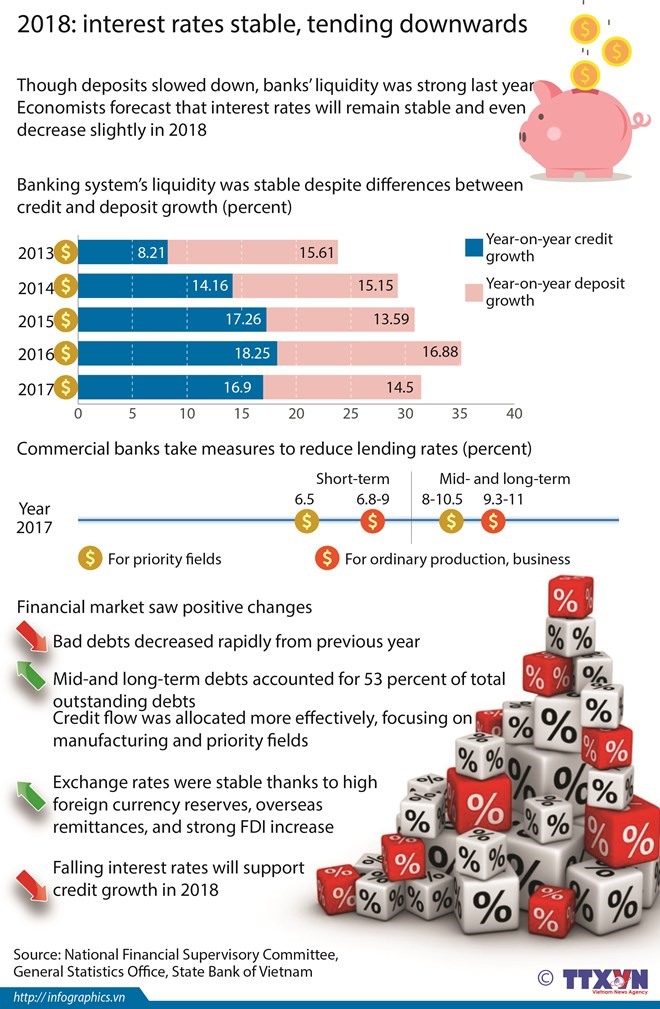 Economy
Economy

Prime Minister Nguyễn Xuân Phúc yesterday required the State Bank of Việt Nam (SBV) to enhance inspection and supervision to ensure the safety of the banking system and increase the confidence of people in the system in 2018.
 |
| A large field in southern Hậu Giang Province’s Vị Thủy District. The central bank’s lending this year will focus on the Government’s priority sectors, such as agriculture, exports, spare-parts industries, small- and medium-sized enterprises and hi-tech firms. VNA/VNS Photo Duy Khương |
HÀ NỘI --- Prime Minister Nguyễn Xuân Phúc yesterday required the State Bank of Việt Nam (SBV) to enhance inspection and supervision to ensure the safety of the banking system and increase the confidence of people in the system in 2018.
At yesterday’s meeting to review last year’s performance and prepare for implementing tasks in 2018, Phúc also instructed the banking industry to boost the restructuring of ailing credit institutions.
Besides ensuring the consumer price index of below 4 per cent, the SBV must also further cut lending interest rate and boost consumer lending this year, Phúc said.
He also required the central bank to create favourable conditions for local commercial banks to enhance financial status and operational efficiency, aimed at having a Việt Nam bank, either State-owned or private, at the regional level soon.
The Prime Minister has so far entrusted two deputy prime ministers of Vương Đình Huệ and Trịnh Đình Dũng as well as the SBV to scrutinise the forecast for the real-estate market after 2019 to help the Government actively have suitable policies for the market.
The SBV also needs to soon have regulations to manage the cryptocurrency as instructed by the Government, Phúc said.
At the meeting, Phúc also appreciated the achievements of the banking industry last year, which contributed significantly to the country’s 6.81 per cent GDP growth.
He said that the central bank bought another US$1 billion for the past few days, raising the nation’s total foreign reserves to new record high of $53 billion.
“High foreign reserves, low inflation and suitable forex policy have helped enhance Việt Nam’s prestige and the confidence of investors, firms and the people,” he said.
 |
At the meeting yesterday, SBV also announced its key monetary management policies for 2018 with a focus on macro-economic stability.
SBV Governor Lê Minh Hưng said that SBV aimed to pursue a proactive and flexible monetary policy to cut interest rates to support local firms, besides stabilising foreign currency and gold markets.
The monetary policy in 2018 would work in close conjunction with fiscal and other macro-economic policies in a move to control inflation and support economic growth at a reasonable level, he said.
“Right after the meeting, the central bank will issue Resolution 01 on implementing tasks of the banking sector in 2018, in which it will instruct credit institutions to consider a rate cut for lending interest,” Hưng said, adding the central bank will also cut the lending rate in the OMO (open market operations) market to aid the institutions.
The central bank announced a credit growth target of 17 per cent for 2018, lower than the 18.17 per cent last year. It will, however, closely monitor the market to make suitable adjustments from time to time.
SBV stated that lending next year would continuously focus on the Government’s prioritised sectors, such as agriculture, exports, spare-parts industries, small- and medium-sized enterprises and hi-tech firms, while limiting the capital to risky industries such as real estate, securities and consumer lending.
As lending in foreign currencies would continue in 2018 as per a recent circular, SBV said it would strictly control such kind of lending to ensure the country’s de-dollarisation policy.
After raising Việt Nam’s foreign reserves to more than US$53 billion to date this year - a record high in recent years - SBV affirmed it would continuously try to increase the country’s foreign reserves this year besides supporting efforts to stabilise the forex market.
Measures will be also taken to stabilise the monetary market and ensure liquidity of the banking system, the central bank has said, adding it will continue the restructuring of credit institutions and settle non-performing loans.
Assessing the monetary policy management in 2017, Governor Hưng said owing to a good foreign currency supply source and a flexible daily reference exchange rate policy, SBV continued the purchase of foreign currencies in 2017, helping the nation’s foreign reserves to hit a new record of more than $53 billion.
Hưng quoted Bloomberg’s assessment which reported that the Vietnamese đồng was one of the most stable currencies in Asia in 2017.
According to him, liquidity of the domestic foreign exchange market last year was good and met the legal demands of local organisations and individuals.
With the synchronous and flexible management of gold-trading activities in accordance with the Government’s Decree 24, the gold market last year continued to be relatively stable, with a decreasing demand for gold bars in the local market, said Hưng.
"Last year, the local market did not see any gold fever and speculation as in previous years, which caused instability in the local foreign exchange market and the country’s macroeconomy. Gold holders converted a part of their gold into the đồng for the cause of socio-economic development," he said.
According to Hưng, the successful monetary management policy last year also contributed to maintaining basic inflation at 1.41 per cent, helping the banking system cut lending interest rate by 0.5-1 percentage points in 2017. --- VNS




